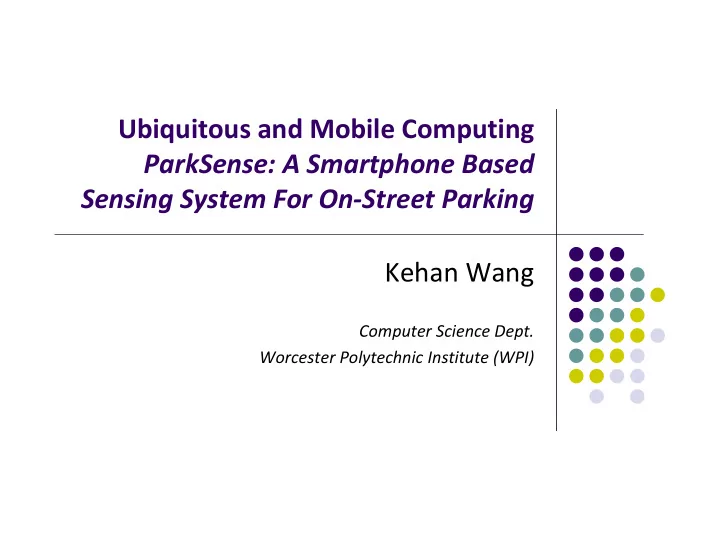

Ubiquitous and Mobile Computing ParkSense: A Smartphone Based Sensing System For On ‐ Street Parking Kehan Wang Computer Science Dept. Worcester Polytechnic Institute (WPI)
Introduction 30% traffic congested by cruising driver looking for parking Solution: Detect empty parking spot on street Requirements: Accurate and Low battery impact
Related Work GPS A ‐ GPS and Network Based localization Accelerometer
Wireless Based Sensing Uses Beacons, a special frame sent from AP to broadcast its SSID Low Energy Consumption
Localization Algorithm 1 User Leaves the car Start sensing (triggered by payment) Sp = {sp(1), sp(2), . . . sp(n)} (SSID array) Wp = {wp(1),wp(2), . . .wp(n)} (Beacon reception ratio array) wp(i) = vp(i) / m vp(i): the number of scans in which a beacon frame is received from AP i
Localization Algorithm 2 User Returning to Car Normalized beacon reception ratios 3 Ways to determine (1) Weighted (2) Weighted Difference (3) Percentage
Localization Algorithm 3 User Driving Away Divide WiFi scans into windows of size m Compute Jaccard similarity between successive windows
Performance Accuracy Accuracy affected by window size:
Performance Power
Discussions Capture real time parking occupancy Low power, equal or higher accuracy compare to GPS and network location based solution Future: integrate into exist parking payment framework Special cases: Personal Hotspot, Not follow particular pattern
References ParkSense: A Smartphone Based Sensing System For On ‐ Street Parking Sarfraz Nawaz, Christos Efstratiou, and Cecilia Mascolo in Proc Mobicom 2013 Elliott D. Kaplan and Christopher Hegarty. Understanding GPS: Principles and Applications. Artech House Publishers, 2 edition, November 2005.
Recommend
More recommend